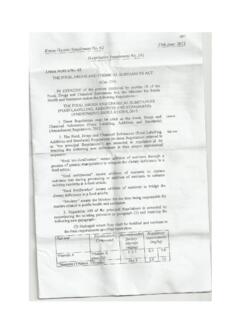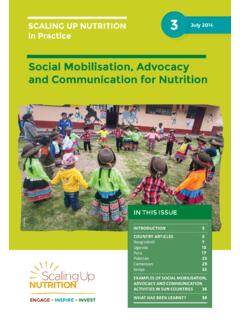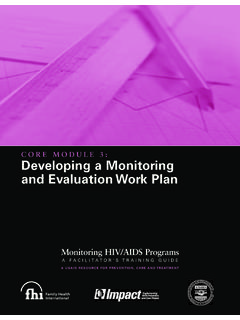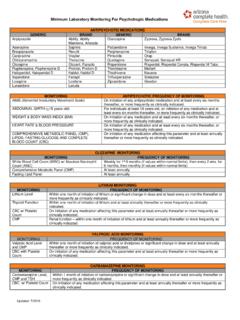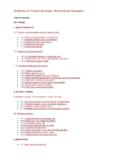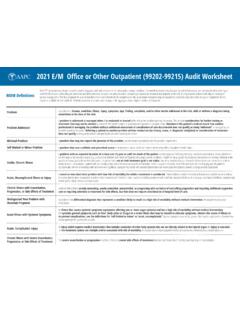Transcription of Monitoring & Evaluation Framework (Final draft)
1 Monitoring & Evaluation Framework (Final draft) SUN Movement 10 April 2013 SUN Movement Monitoring & Evaluation Framework Final Draft Table of Contents Page 3 of 53 Table of Contents Page ABBREVIATIONS .. 4 1. INTRODUCTION .. 5 2. INTENDED USE OF THE M&E Framework .. 7 3. M&E Framework AT IMPACT LEVEL .. 8 4. M&E Framework AT OUTCOME LEVEL .. 10 NETWORK OUTCOMES AT COUNTRY LEVEL .. 11 NETWORK OUTCOMES AT GLOBAL LEVEL; .. 33 LEAD GROUP OUTCOMES (WORK IN PROGRESS) .. 41 5. Monitoring OUTPUTS .. 42 6. Monitoring PLAN OF OUTCOMES .. 52 Annex 1: Outcome Monitoring Plan .. 55 Abbreviations Page 4 of 53 Abbreviations CFS Committee on World Food Security CSA Civil Society Alliance (refers to CSO Network at country level) CSO Civil Society Organisation LG Lead Group MSP Multi-Stakeholder Platform PM Progress Marker PPP Public Private Partnership REACH Renewed Efforts Against Child Hunger and undernutrition SBN SUN Business Network SCN Standing Committee for Nutrition SMS SUN Movement Secretariat SUN Scaling Up Nutrition UN United Nations WHA World Health Assembly WHO World Health Organisation Introduction Chapter1 Page 5 of 53 1.
2 Introduction The SUN Movement has committed itself to the development of a comprehensive Monitoring and Evaluation (M&E) Framework to provide a sound and practical basis for measuring the progress and effectiveness of the Movement as a whole. The first complete version of this M&E Framework is reflected in this document and consists of three complementary components (see Figure below). The document was developed in consultation with SUN Networks. A Reference Group, consisting of representatives of all Networks, and Lead Group were constituted to support this work. A two-day design workshop was held in Geneva on 07 & 08 March 2013. The M&E Framework brings together, in one document, the expected results of the Movement and stakeholder commitments as outlined in the SUN Movement Strategy and Roadmap and in individual Network planning documents. Figure Schematic overview of different components M&E Framework The SUN Movement Monitoring and Evaluation Framework is presented as three linked parts, each with a distinct purpose.
3 The methods used in each part are described in chapters two, three and four of this document; in each case they are tailored to reflect the purpose they seek to pursue: a. Monitoring the impact of efforts to Scale Up Nutrition within SUN countries: Impact is assessed by documenting the changes in the nutritional status of women and children, and linking these changes to actions undertaken within SUN countries. Impact assessment is undertaken within SUN countries using standardized survey procedures (Demographic and Health Surveys, for example) and computing the average annual rate of reduction for selected variables such as prevalence of chronic malnutrition in children under five Introduction Chapter1 Page 6 of 53 years of age. In March 2013 the SUN Movement s Donor Network proposed expanding impact Monitoring through the creation of a Networked Information System that brings together and enriches existing survey procedures to make a more robust assessment.
4 Chapter 2 summarises this part of the SUN Movement s M&E Framework and indicates the proposed principles of the Networked Information System. b. Monitoring the outcomes of efforts to Scale Up Nutrition as practiced by different stakeholders within the SUN Movement: This part of the M&E Framework including a description of how the contribution of these stakeholders is measured and reported is presented in Chapter 3. It forms the core of this document. A distinction is made between outcomes delivered by stakeholders at country level (governments of SUN countries and other in-country stakeholders blue actors in figure ) and outcomes that cover groups of countries delivered by global stakeholders (the collective of SUN countries, SUN networks and the SUN Movement Lead Group orange actors). c. Monitoring the services (outputs) provided by the SUN Movement Secretariat (SMS) and assessing their contribution to the SUN Movement: This takes account of commitments made by the SMS to monitor and report on the contribution of its services to the ways different parts of the SUN Movement function.
5 It draws on existing logical frameworks for the Monitoring of the SMS. Chapter 4 contains this part of the Framework . Intended use of the M&E Framework Chapter2 Page 7 of 53 2. Intended use of the M&E Framework The M&E Framework provides a Framework for the collection of data with a view to determine impact, outcomes and outputs of the SUN Movement through the actions of its constituent parts. In measuring impact, the M&E Framework assumes the use of secondary data that will be collected at country level and collated by the SMS. In measuring outcome, the SMS, Government Focal Points and the Network Facilitators will take the lead in collecting and reporting data related to their contribution to the SUN Movement, including an explanation / contextualisation of progress made. Other members of the Movement may be asked to provide inputs to increase the quality and efficiency of data collection, but final responsibility for adequate and timely reporting lies with them (more details are provided in the Monitoring plan in annex 1).
6 At output level, it is expected that the SMS will collect and report on relevant data. The M&E Framework is a living document, which aims to help map and understand the Movement s progress in its implementation of the SUN Movement Strategy. The successful use of the Framework will be dependent on all SUN stakeholders, particularly the SUN Network and SMS, ensuring that the necessary information on the parts of the Framework directly relevant to them is collected and reported upon in a timely manner. It is suggested that each year a space is created to discuss the need for adaptation to all three components of M&E Framework , without losing sight of its overall purpose of mutual accountability. Movement-wide Monitoring information will be collated and reported upon annually by the SMS along with an analysis of progress made across the Movement. Based on this, the SMS may formulate recommendations or highlight strategic choices to be made by the Lead Group and the different members of the Movement, including revisions to the M&E Framework itself.
7 These inputs are expected to enrich the members own assessments of the Monitoring findings. M&E Framework at Impact Level Chapter3 Page 8 of 53 3. M&E Framework at Impact Level Impact Monitoring primarily serves the purpose of learning and steering. Gaining an insight into changes in the nutritional status of women and children in SUN member countries is crucial to determine how well interventions work under which circumstances. This in turn is expected to inform decision-making in SUN countries, in particular in relation to priority-setting and work methods in the future. As mentioned above, impact Monitoring relies entirely on secondary data; therefore the underlying methodology for collecting this data will not be elaborated upon here. The impact of the SUN Movement will be reflected in the extent to which SUN countries demonstrate significant reductions in undernutrition, referenced by the global targets established by the 2012 World Health Assembly: 40% reduction of the global number of children under five who are stunted; Reducing and maintaining child wasting to less than 5%; 30% reduction of low birth weight; No increase of child overweight; 50% reduction of anaemia in women of reproductive age; Increase exclusive breastfeeding rates in the first six months of life up to at least 50%.
8 In addition to global nutrition-related targets, SUN countries have established national nutrition goals that address direct and underlying causes of undernutrition, such as increased access to affordable nutritious food, clean water, sanitation, healthcare and social protection. Based on existing well-accepted secondary data sources (see the list below), the SMS tracks the data that indicate progress made towards meeting both global nutrition targets and country-specific nutrition goals. SMS makes this data comparative across countries and available for SUN members annually, as part of a common M&E / Progress report. This is done to enable the SUN Movement to link information on the nutrition situation in countries to progressive changes in behaviour of countries and networks, and to be in a better position to establish priority actions and determine where significant increases in investment are needed. The SUN Movement annually makes available comparative data1 across SUN countries on the following indicators of nutrition.
9 In line with the WHA global nutrition targets Nutrition-specific Nutrition-sensitive U5 Stunting U5 Wasting U5 Over Weight 4+ food groups (6-23) Children 3 IYCF (6-23) Zinc treatment Access improved water (% pop) Access improved sanitation (% pop) 1 With break down of urban/rural, age and income groups, among others M&E Framework at Impact Level Chapter3 Page 9 of 53 Low-birth weight 0-6 months Exclusive Breastfeeding 4+ ANC for pregnant women De-worming (12-59) Vitamin A (6-59) Presence of iodized salt in household Access to primary school enrolment Un-met need for family planning % Births attended by skilled health personnel Nutrition awareness- building by improving mass media coverage in collaboration with private sector These indicators form a core, but not exhaustive, list of changes that the SUN Movement will track on an annual basis Additional indicators, specific to business or particular sectors, will be added on an as-needed basis and tracked, assuring that the technical quality of data is acceptable.
10 Information from WHO is considered as the primary data source. In addition, when available and up-to-date, data is sourced from Multiple Indicators Cluster Surveys (MICS) and/or Demographic Health Surveys (DHS) reports. If the latter is not available or out-of-date, SMART survey data and other validated national survey (only when it meets certain technical criteria) are used, like: National Family Health Surveys National Maternal-Infant Health Surveys (ENSMI) Nutrition and food security survey In addition, for data on nutrition-specific and -sensitive indicators: FAO Strengths, weaknesses, opportunities and constraints/threats (SWOC) Database of Joint Monitoring Programme for Water Supply and Sanitation (JMP) The State of the World's Midwifery Report (SOWMR) Similar to impact indicators, reliable data sources will be added, as needed, to satisfy requests of SUN member countries and networks in tracking the sector-specific changes on impact level.


